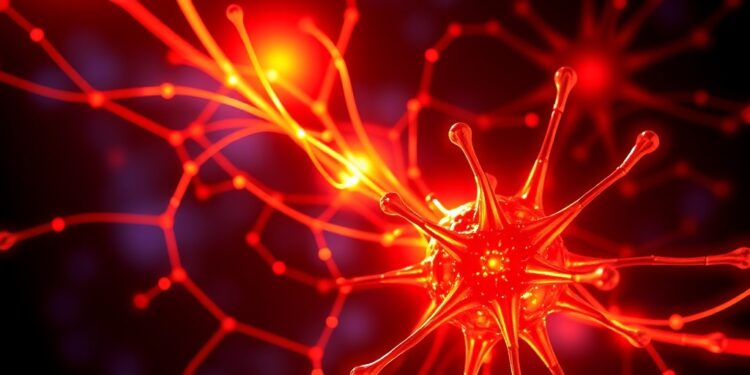Researchers from the Ludwig Maximilian University of Munich (LMU) and the Massachusetts Institute of Technology (MIT) have made groundbreaking strides in understanding the dynamic shape alteration of cells, a foundational characteristic of all living organisms. Utilizing starfish oocytes, the study unravels the finely-tuned interplay between cellular structure and environmental factors that govern cellular behavior, promising profound implications for the fields of synthetic biology and biomimetic materials. Their combined approaches of theoretical modeling and experimental manipulation of light stimuli have revealed the intricate mechanisms involved in these processes.
At the core of this research is the ability of cells to change shape, a vital action necessary for fundamental life processes such as cell division. Without shape alteration capability, cells would be unable to carry out essential functions effectively. The research team led by LMU physicist Erwin Frey and MIT’s Nikta Fakhri delved into how cells respond to external signals and adapt their forms accordingly. Employing oocytes from the starfish species Patiria miniata, the researchers harnessed these cells’ natural shape-changing abilities, allowing for unprecedented control over their morphological transformations.
Previous studies had already hinted at the significant role that self-organizing proteins play in determining cell shape, but this groundbreaking work digs deeper, combining both experimental and theoretical methodologies to build a comprehensive model for understanding the mechanics of cell deformation. By isolating two pivotal enzymes, the small GTPase Rho and its activation enzyme GEF, the research team was able to illuminate the biological underpinnings of shape dynamics. The incorporation of light-responsive molecular switches into GEF enzymes was particularly revolutionary, enabling targeted manipulation of cellular shape changes.
When exposed to light stimuli, these molecular switches allowed for a phenomenal degree of modulation in protein distribution within the cell, resulting in diverse morphological variations. This phenomenon ranged from localized deformations – where the changes were confined to specific areas of the cell – to more dramatic alterations whereby entire cells transformed into unconventional forms, including distinctly square shapes. Lead author of the study, Tom Burkart, elucidated that this capacity to arbitrarily induce deformations represents a significant leap forward in the field.
The theoretical framework developed alongside these experiments articulates the dual mechanisms responsible for cell shape dynamics: guided and unguided deformations. Guided deformations are characterized by localized changes, while unguided deformations arise from self-organizing processes that can diffuse throughout the cellular structure. These findings suggest a level of versatility in living cells that surpasses previous scientific assumptions, expanding the potential applications within synthetic biology, where engineers might design cells and materials that mimic these adaptive properties.
The researchers’ innovative approach to understanding the dynamics of cell shape changes opens up a wealth of possibilities for future technological advancements. Potential applications could span numerous domains, from the manufacturing of bio-inspired materials that can adapt to varying environmental challenges, to the development of synthetic cells that replicate natural processes more efficiently. As the interplay between chemical signaling and mechanical responses is further understood, the promises of customizing cellular functions could lead to breakthroughs in regenerative medicine, cancer therapy, and biotechnological applications.
Furthermore, the collaborative effort between LMU and MIT reflects a growing trend in interdisciplinary research that combines advanced physics with biological studies. The ability to manipulate cellular functions through light control not only showcases the power of modern technology in biology but also emphasizes the importance of a multifaceted approach to complex scientific questions.
With significant support from teams of researchers working across multiple institutions, the findings published in the respected journal Nature Physics push the boundaries of what is currently known about cellular mechanisms. This pioneering research, which outlines how light-induced stimuli can program cell shape dynamics, is anticipated to become a cornerstone in the ongoing dialogue regarding synthetic biology. As the scientific community digs deeper into these revelations, we can expect more innovative solutions that harness the principles established by this work.
It is essential to acknowledge that these advancements come on the heels of an exponential improvement in optogenetic techniques, which allow scientists to manipulate cellular processes using light. As the understanding of these methodologies continues to evolve, their applications could redefine the boundaries between engineered and natural biological systems.
This research encapsulates a vivid intersection between light and life, illuminating not just the mechanics of cellular response but also the immense potential for future applications that could change the landscape of biology as we know it. By harnessing the inherent capabilities of living cells and understanding their responsive nature, we may soon unlock the door to entirely new realms of bioengineering.
This study distinctly marks a significant step into an era where the manipulation of life at the cellular level becomes more transparent and controllable. With further advancements anticipated in the field of synthetic biology, the future may be ripe with opportunities for innovation that could mimic the exquisite intricacies of life itself.
Subject of Research: Dynamic shape alteration of cells through light stimuli
Article Title: Light-induced cortical excitability reveals programmable shape dynamics in starfish oocytes
News Publication Date: 24-Mar-2025
Web References: DOI link
References: Available in the cited journal article.
Image Credits: Not specified.
Keywords
Cell dynamics, synthetic biology, optogenetics, shape alteration, starfish oocytes, molecular switches, biological patterns, engineered cells, biomimetic materials, interdisciplinary research.




